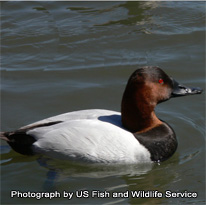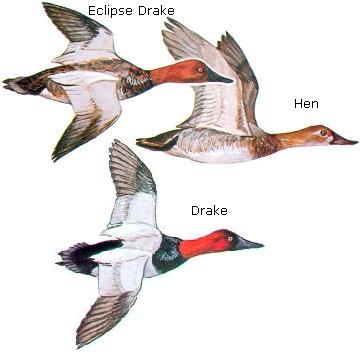Wildlife - Species

Species Specific Regulations
Canvasback
Licenses: Hunting License required. Migratory Bird Hunting and Conservation Stamp (Federal Duck Stamp) that is validated by the hunter signing the stamp in ink across the face of the stamp
Limits: Please see Migratory Bird Regulations for any game zones restrictions or Limitations.
Canvasback (Aythya valisinera )

Description
Canvasbacks can be distinguished from other ducks by their large body size and sloping profile. The drake is known for his rusty head, white body, and black chest.
Average Size
Canvasbacks have an average length of 22 inches and an average weight of 3 pounds.
Range
Canvasbacks are found in all four flyways, but they are most common in the Pacific and the Mississippi. In South Carolina they can primarily be found on the eastern half of the state during the winter months.
Preferred Habitat
In the summer months canvasbacks are found in a variety of freshwater habitats including small lakes, deep wetlands, permanent and semipermanent ponds, sloughs, ponds, and river impoundments. They also use a wide range of habitats in the winter months, including deep freshwater lakes, coastal brackish and salt water estuaries, shallow bays and harbors, and riverine deltas.
Typical Flock Pattern

Wings

Food Habits
The diet of the canvasback varies with availability. During the breeding season they consume both plants and animals, including seeds, buds, tubers, snails, and aquatic invertebrate. But during the winter they eat mainly plant material, only eating clams and snails when plant material is scarce.
Reproduction
Mated pairs form during spring migration and early on the breeding grounds. The female builds the nest in emergent vegetation, over water, and occasionally on land. The female builds a large, bulky, structure consisting of woven together plant material and lined with finer material and down. Once complete she lays 5-11 greenish drab eggs.
Sound
Drakes croak, peep, and growl, and hens have a mallard-like quack.
Behavior
- Normally late to start south, canvasbacks migrate in lines and irregular V’s.
- Their speed is the swiftest of all our ducks.
- Rarely seen on dry land.
- No evidence of territoriality during the breeding season.
- Occur in large dense flocks on the wintering grounds.
Publications and Literature
U.S. Fish & Wildlife Service, Federal Duck Stamp Office Presents: North American Waterfowl (Adobe PDF file)
Mowbray, Thomas B. 2002. Canvasback (Aythya valisineria), The Birds of North America Online (A. Poole, Ed.). Ithaca: Cornell Lab of Ornithology; Retrieved from the Birds of North America Online
South Carolina waterfowl hunters 16 and older are required by state law to obtain a state migratory waterfowl permit and Migratory Game Bird permit. Both permits must be in the hunter's possession while hunting or transporting legal waterfowl. A state waterfowl permit is included with the Lifetime Senior, Lifetime Gratis and Disability Licenses. S.C. residents who hold a Lifetime Senior or Lifetime Gratis License are not required to have a Migratory Game Bird permit.
National Migratory Bird Harvest Information Program (HIP)
The waterfowl permits and HIP permits are available from select DNR offices and from hunting and fishing license agents.